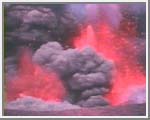|
COMETS EARTH JUPITER KUIPER BELT MARS MERCURY METEORITES NEPTUNE OORT CLOUD PLUTO SATURN SOLAR SYSTEM SPACE SUN URANUS VENUS ORDER PRINTS
PHOTO CATEGORIES SCIENCEVIEWS AMERICAN INDIAN AMPHIBIANS BIRDS BUGS FINE ART FOSSILS THE ISLANDS HISTORICAL PHOTOS MAMMALS OTHER PARKS PLANTS RELIGIOUS REPTILES SCIENCEVIEWS PRINTS
|
Related Document
Download Options
This video clip was taken from "Understanding Volcanic Hazards", © 1995, International Association of Volcanology and Chemistry of Earth's Interior (IAVCEI). The following was taken from the video: An exploding volcano blasts molten rock and ash into the air with tremendous force. The heaviest fragments fall back to the ground usually within a few kilometers of the vent but the dust size ash fragments continue to rise into the air forming a hugh billowing cloud of ash. This is the most common type of activity produced by explosive eruptions. |
